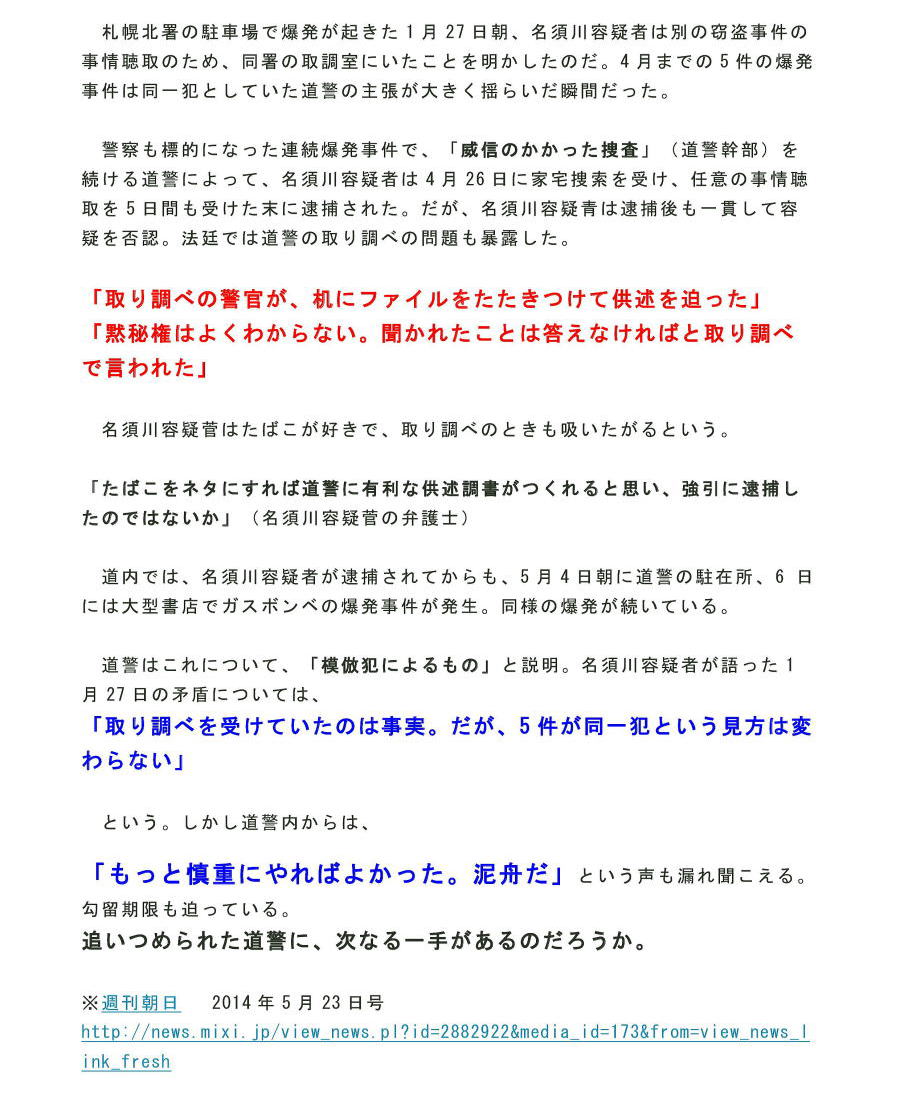カボニエール氏は、因習を打破する姿勢で広く知られており、反体制的な同紙の看板的存在だった。シャルリー・エブド紙はこれまでも、政治や宗教などさまざまなジャンルの有名人を攻撃する風刺画を数多く掲載してきている。中でも一番注目を集めたのは、イスラム教ならびに預言者ムハンマドに関する表現だった。2011年には、ムハンマドを同紙の新しい編集長に指名したという風刺画を掲載。その翌日には、同紙事務所に火炎瓶が投げ込まれ、全焼する事件が起きた。
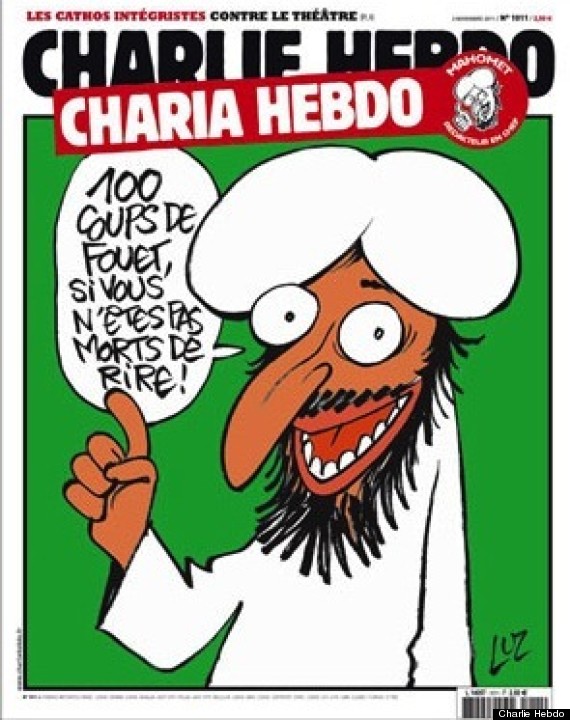
2011年に発表された風刺画には、
「笑いすぎて死ななかったら、むち打ち100回の刑だ」というセリフがついている。この号の発売後、同紙事務所には火炎瓶が投げ込まれた。 |
同紙は2011年にさらに、預言者ムハンマドを同性愛者として描いた風刺画を掲載した。その結果、同紙ウェブサイトはハッカーの被害を受けている(以下の画像)。
2012年には、フランス当局から警告を受けていたにも関わらず、ヌード姿のムハンマドの絵を複数掲載した。カボニエール氏はAP通信に、預言者ムハンマドを風刺する漫画の掲載決定について次のように主張した。「ムハンマドは私にとって聖なる存在ではない。イスラム教徒がこの漫画を見て笑わないのは仕方がない。しかし、私はフランスの法の下に生活しているのであって、コーランに従って生きているわけではない」
カボニエール氏が最後に描いた漫画から、シャルリー・エブド紙が絶えずさらされていた脅威を軽く見ていたことがわかる(カボニエール氏は複数の殺害脅迫を受けており、警察当局の保護下にあった)。
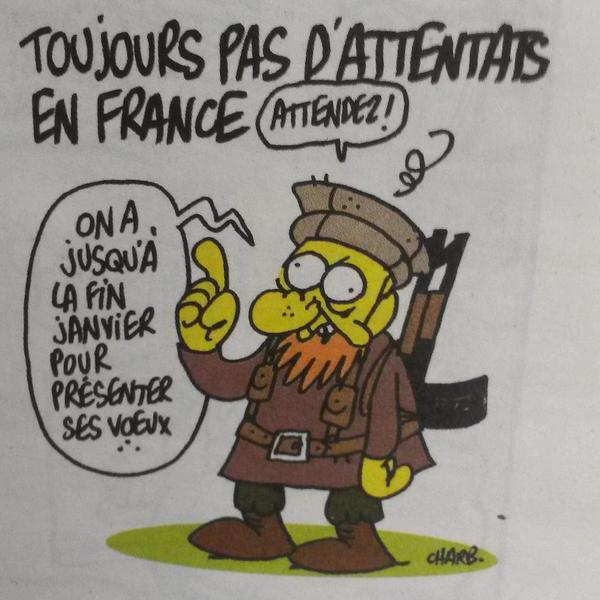
「フランスにはまだ攻撃が行ってないな。1月末までには季節の挨拶ができるぞ」 |
カブー氏(76歳)は同紙の常連漫画家で、かつてはフランスの有名な映画監督ジャン=リュック・ゴダール氏に「フランス一のジャーナリスト」と評された人物である、と英紙「テレグラフ」は伝えている。また、シャルリー・エブド紙の前身である月刊誌「アラキリ(Harakiri:日本語の切腹の意 フランスでは「アラキリ」と発音する)」の共同創刊者でもあった。アラキリ誌は、1970年代に発禁処分を受けたため、「シャルリー・エブド」に改名したという背景がある。カブー氏は2006年、同紙の表紙に、「バカに愛されるのもラクじゃない」というキャプション付きで、預言者ムハンマドが頭を抱える風刺画を描いた。2つのイスラム教系団体がこの風刺画をめぐって訴訟を起こしたが、敗訴したとニューヨーク・タイムズ紙は伝えている。
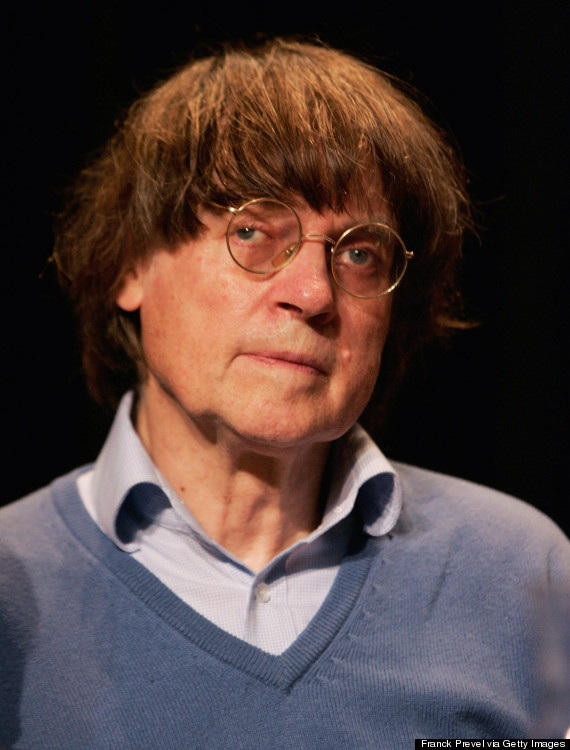
シャルリー・エブド紙の風刺漫画家カブー氏が、2011年11月3日に
パリのロン・ポアン劇場での記者会見に出席した時の様子。 |
ジョルジュ・ウォリンスキ氏(81歳)はチュニジア生まれのユダヤ人で、1940年に家族とともにフランスに移り住んだ。カブー氏と同様、1960年代には「アラキリ」誌に漫画を掲載していた。
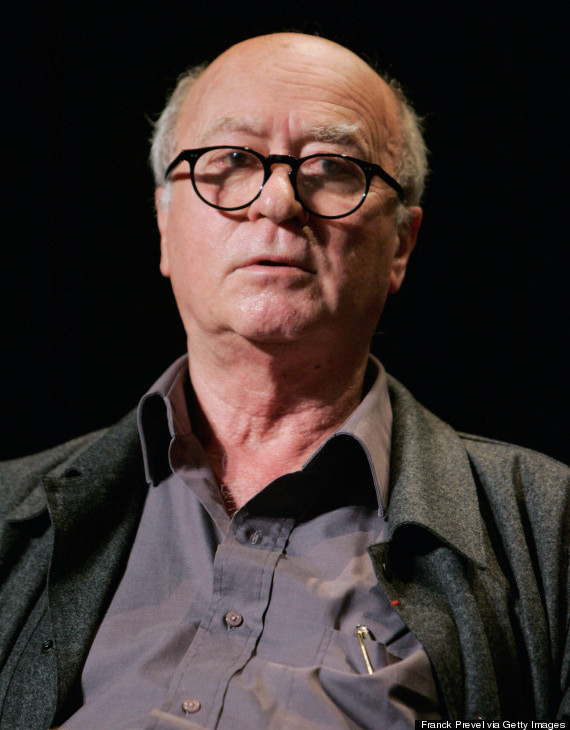
シャルリー・エブド紙の風刺漫画家ジョルジュ・ウォリンスキ氏が、
2011年11月3日にパリのロン・ポアン劇場での記者会見に出席した時の様子。 |
シャルリー・エブド紙は2006年、「原理主義者に悩まされて困り果てたムハンマド」という見出し付きで、すすり泣くムハンマドの漫画を掲載し、物議をかもした。同号にはさらに、預言者ムハンマドの風刺画が12枚掲載され、イスラム世界からかつてないほどの批判が寄せられた(これは、もともとはデンマークのユランズ・ポステン紙が2005年に発表して問題になった預言者ムハンマドの風刺漫画を掲載したものだった)。
最終的には、フランス国内に住む500万人のイスラム教徒を代表する組織「フランス・イスラム評議会」が、同週刊紙を訴える事態となった。この号がきっかけとなって、シャルリー・エブド紙はテロリストの攻撃対象としてみなされるようになったと考えられている。
さらに最近の号では、イスラム国が預言者ムハンマドの首を切るマンガを掲載していた(以下のTwitter画像)。 この記事はハフポストUS版に掲載されたものを翻訳しました。[日本語版:遠藤康子/ガリレオ]
|
|
 |
| Stephane Charbonnier, right, editor-in-chief of the French publication
Charlie Hebdo, was interviewed in 2012 by VOA's Arzu Çakır. Charbonnier
was killed in an attack that left at least 12 people dead, in Paris, France,
Jan. 7, 2015. |
|
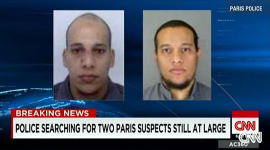 |

2015.01.08 Thu posted at 12:24 JST |
(CNN) フランス・パリの風刺週刊紙「シャルリー・エブド」が襲撃され12人が死亡した事件で、国家警察は逃走中の容疑者2人の氏名と顔写真を公開し、市民に情報提供を呼びかけた。
手配されているサイド・クアシ容疑者とシェリフ・クアシ容疑者は兄弟で、いずれも30代。武器を持っている恐れもあるとして警察は警戒するよう促している。
一方AFP通信は関係者の話として、襲撃にかかわった18歳の容疑者が警察に出頭したと伝えた。CNNでは出頭の情報は確認できていない。
警察はフランス全土で容疑者の行方を追っており、CNN系列局のBFMTVによれば、パリから約144キロ離れたランスに戦術部隊が配備された。作戦の内容は不明だが、メディア各社は警察が容疑者を追い詰めているのかもしれないと伝えている。
米司法当局者によれば、容疑者の1人は米当局も把握している人物で、連邦捜査局(FBI)などが交流関係や接触した相手、インターネットへの投稿などを調べている。
この事件では7日、シャルリー・エブドのオフィスに覆面をした男2人が押し入って銃を乱射し、12人が死亡、11人が負傷した。負傷者を手当てした医師によると、男たちは特定の人物を名指しし、男性を女性から離れさせたうえで銃撃したという。銃撃は無差別に行われたわけではなく、用意周到な処刑のようだったと医師は話している。
検察や警察によると、現地時間の同日午前11時ごろ、シャルリ・エブドーのオフィスがある建物の前に乗り付けた車から、自動小銃と思われる武器を持った覆面姿の2人が降りた。
2人は管理人にシャルリ・エブドーのオフィスはどこだと尋ねて発砲し、1人を殺害。オフィスのある2階に上がって編集室で銃を乱射し、さらに10人前後を殺害した。
検察によると、男たちは「アラーは偉大だ」と叫び、預言者ムハンマドの復讐を口にしていたという。建物を出た男たちはもう1人の容疑者と合流して車で逃走。逃げる途中で警察と銃撃戦になり、警官1人を撃った。その後別の車を乗っ取って逃走を続けた。
この事件で、シャルリー・エブドの編集者で漫画家のステファン・シャルボニエ氏のほか、著名漫画家3人を含む同紙の記者7人と、ビルの管理人、同紙の訪問客1人、警察官2人が死亡した。 |
 |
VOA News
Last updated on: January 07, 2015 3:09 PM
The French satirical weekly newspaper Charlie Hebdo had just tweeted a cartoon mocking Islamic State group leader Abu Bakr al-Baghdadi when masked gunmen burst into its Paris office Wednesday.
Paris police said at least 12 people were killed, including two police officers, and at least 11 others were injured, with four listed in critical condition.
Ten members of the Charlie Hebdo staff died in the attack, prosecutors said. Among the dead were three cartoonists, including co-founder Jean “Cabu” Cabut and editor-in-chief Stephane “Charb” Charbonnier.
Charlie Hebdo, which publishes every Wednesday, is known for being irreverent, anti-establishment and virulently anti-religious.
Police said the weekly had received several threats in recent weeks and had permanent police protection.
Caricatures of Muslims
From publishing the Danish cartoons of the Prophet Muhammad that sparked Middle East riots in 2005 to renaming an edition Sharia Hebdo and listing Islam's prophet as its supposed editor-in-chief, the weekly has repeatedly caricatured Muslims and their beliefs.
It is renowned for courting controversy with satirical attacks on political and religious leaders.
Many of its cartoonists started in the 1960s on Hara-Kiri magazine, which openly proclaimed its aim to be “inane and nasty.” It was banned in 1970 after printing a mock death notice for General Charles de Gaulle, only to reappear months later under the name Charlie Hebdo.
But its attacks on Muslims have caused the most controversy, including a court case on charges of racism and the firebombing of its offices in 2011 after the Sharia Hebdo edition. “Hebdo” is French slang for a weekly newspaper.
The weekly has had permanent police protection since the firebombing incident.
The weekly has also made fun of the Muslim veil for women and ridiculed Islamist extremists. In the edition publishing the Danish cartoons, its cover had a drawing of the Prophet Muhammad in tears, saying: “It's hard to be loved by jerks.”
The racism case went to court in 2007, but the plaintiffs -- two leading French Muslim groups and the Saudi-backed Muslim World League -- stood no chance against the weekly's defense that France's freedom of speech and separation of church and state guaranteed its right to criticize any religion.
Free speech vs agitation
Because of its relentless criticism of many public figures and institutions, Charlie Hebdo's often crude -- many Muslims would also say cruel -- caricatures are seen in France more as free speech rather than far-right, anti-Muslim agitation.
In 2012, the publication again published Muhammad caricatures, depicting the prophet in naked and pornographic poses, which drew denunciations from around the Muslim world. These caricatures forced France to temporarily close embassies and schools in more than 20 countries amid fears of reprisals.
Stephane Charbonnier, right, editor-in-chief of the French publication Charlie Hebdo, was interviewed in 2012 by VOA's Arzu Çakır. Charbonnier was killed in an attack that left at least 12 people dead, in Paris, France, Jan. 7, 2015.
Stephane Charbonnier, right, editor-in-chief of the French publication Charlie Hebdo, was interviewed in 2012 by VOA's Arzu Çakır. Charbonnier was killed in an attack that left at least 12 people dead, in Paris, France, Jan. 7, 2015.
In a 2012 interview with VOA's Turkish service, editor Charbonnier had answered questions regarding the magazine’s take on an anti-Islamic movie called Innocence of Muslims.
He said the weekly had not defended the movie, which he characterized as vulgar. He instead said the magazine caricaturized the film itself.
Charbonnier, who said he is an atheist, said that he stays clear of mosques and churches because he always encounters shocking statements or discourse in those venues. In the same light, he stated that if believers do not want to be shocked, they should not read Charlie Hebdo.
Attacks on all religions
Reuters reported in 2012 that Charbonnier had been under police protection since the 2011 firebombing.
"This is a satirical paper produced by left-wingers and when I say left-wingers that goes all the way from anarchists to communists to Greens, Socialists and the rest. Above all it is a secular and atheist newspaper," Charbonnier told Reuters at the time.
"When we attack the Catholic hard right ... nobody talks about it in the papers. It's as if Charlie Hebdo has official authorization to attack the Catholic hard right. But we are not allowed to make fun of Muslim hardliners. It's the new rule ... but we will not obey it," he said in 2012.
In a 2011 interview with Germany's Der Spiegel, Charbonnier said, “If we worried about the consequences of each of our drawings in each of our 1,057 issues, then we would have had to close shop a long time ago.
“Extremists don’t need any excuses,” he said following the firebombing of his magazine offices, in which no one was hurt. "If they are not amused by our cartoons, they don't need to buy our magazine. Of course they are allowed to demonstrate. The right to protest needs to be protected, so long as one abides by the law and refrains from violence."
Minutes before the attack Wednesday, Charlie Hebdo had tweeted a satirical cartoon of the extremist Islamic State group's leader with a New Year's message that read: "Best wishes, by the way."
The extremist leader has previously urged his followers to attack citizens of the U.S., France and other countries involved in an international coalition, whose goal is to destroy the Islamic State group.
VOA's Turkish service contributed to this report. Some material for this report came from Reuters and AP. |
|

